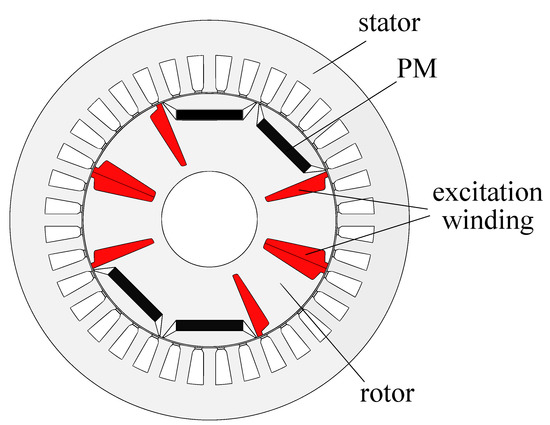Since they can keep their speed steady under any load, synchronous motors are widely utilized in many different sectors. Among these, the Hybrid Synchronous Motor and the Reversible Synchronous Motor stand out as specialized types, each designed for distinct applications. This article will provide an in-depth comparison between these two motor types, highlighting their working principles, key differences, advantages, and typical applications. Additionally, charts and data will be included to help better understand their performance metrics.

What is a Hybrid Synchronous Motor?
A Hybrid Synchronous Motor is a combination of a synchronous motor and a permanent magnet motor. It uses both the principle of magnetic field induction and permanent magnets to generate torque. Hybrid synchronous motors are designed to provide higher efficiency, improved power factor, and better dynamic response in comparison to conventional synchronous motors.
Key characteristics of Hybrid Synchronous Motors:
- Magnetic Field Generation: The motor relies on both an externally excited rotor and permanent magnets to create a rotating magnetic field.
- Efficiency: By using permanent magnets, the motor reduces the need for external excitation, which minimizes energy loss.
- Power Factor: Hybrid synchronous motors generally have a high power factor, making them ideal for industrial applications that require stable power delivery.

What is a Reversible Synchronous Motor?
A Reversible Synchronous Motor, as the name suggests, is a type of synchronous motor that can reverse its direction of rotation. In applications where the motor’s direction must be changed frequently, this feature is crucial. Reversible synchronous motors are capable of switching rotation direction without requiring any external adjustments to the motor’s internal wiring.
Key characteristics of Reversible Synchronous Motors:
- Reversibility: The motor’s ability to switch rotational direction makes it suitable for applications requiring variable motion, such as conveyor belts, cranes, and automated machinery.
- Constant Speed: Reversible synchronous motors provide consistent performance because, like other synchronous motors, they operate at a steady speed regardless of the load.
- Excitation Requirements: They often use a wound rotor or permanent magnet rotor for excitation, depending on the specific design.
Comparison: Hybrid Synchronous Motor vs Reversible Synchronous Motor
Construction and Design
The construction of both types of motors is based on the fundamental principles of synchronous motor technology. However, the key difference lies in their rotor designs and excitation mechanisms.
Hybrid Synchronous Motor:
Includes a rotor that is excited externally and by permanent magnets. The combination allows the motor to operate efficiently at lower speeds while providing higher torque density.
This hybrid design makes the motor more compact and efficient, suitable for high-performance applications requiring minimal energy losses.
Reversible Synchronous Motor:
Uses either a wound rotor or a permanent magnet rotor, depending on the specific design. The key feature is the ability to reverse the rotation direction, achieved through electrical or mechanical switching.
This type of motor is built to handle frequent direction changes, making it ideal for applications where reverse motion is required.
| Feature | Hybrid Synchronous Motor | Reversible Synchronous Motor |
| Rotor Type | Permanent magnet + external excitation | Wound rotor or permanent magnet rotor |
| Efficiency | High due to the use of permanent magnets | Moderate to high |
| Reversibility | Not inherently reversible | Capable of reversing direction |
| Applications | High-performance, energy-efficient systems | Systems requiring direction change, such as conveyors |
Efficiency and Power Factor
Motors’ appropriateness for industrial applications is largely determined by their efficiency and power factor.
Hybrid Synchronous Motor:
- Efficiency: Due to the use of permanent magnets, these motors exhibit high efficiency by reducing losses associated with the excitation of the rotor.
- Power Factor: The power factor of hybrid synchronous motors is typically higher than that of conventional motors, making them more effective in systems where power stability is critical.
Reversible Synchronous Motor:
- Efficiency: The efficiency of reversible synchronous motors is generally lower than that of hybrid synchronous motors. The presence of additional components like brushes or external excitation systems can lead to energy losses.
- Power Factor: While still relatively high, the power factor of reversible synchronous motors can vary based on the excitation method and load conditions.
| Feature | Hybrid Synchronous Motor | Reversible Synchronous Motor |
| Efficiency | High | Moderate to high |
| Power Factor | High | Moderate |
Torque and Speed Characteristics
These motors’ torque and speed characteristics dictate which applications they are suitable for.
Hybrid Synchronous Motor:
Hybrid synchronous motors provide high torque with a better torque-to-weight ratio than traditional motors.
In applications like robotics and precision machinery, these motors’ ability to maintain a steady speed under a range of load circumstances is crucial.
Reversible Synchronous Motor:
Reversible synchronous motors are designed to maintain constant speed, even under load fluctuations. However, they tend to deliver less torque compared to hybrid synchronous motors of similar size.
The ability to reverse the direction quickly is a significant advantage in applications like material handling, where load direction changes are frequent.
| Feature | Hybrid Synchronous Motor | Reversible Synchronous Motor |
| Torque | High torque density | Moderate to high |
| Speed Stability | Constant | Constant |
Applications
Based on their features and designs, the two motors have distinct uses.
Hybrid Synchronous Motor:
Applications: Hybrid synchronous motors are ideal for energy-efficient systems where high torque, precision, and efficiency are needed. Common applications include robotics, automotive systems, HVAC systems, and high-speed precision machinery.
Reversible Synchronous Motor:
Applications: In applications where frequent directional changes are necessary, reversible synchronous motors perform exceptionally well. They are widely used in material handling systems like conveyor belts, cranes, and automated machines, where the rotation direction needs to be reversed on demand.
| Application Area | Hybrid Synchronous Motor | Reversible Synchronous Motor |
| Robotics | ✔️ | ❌ |
| Conveyor Systems | ❌ | ✔️ |
| Automotive | ✔️ | ❌ |
| Material Handling | ❌ | ✔️ |
Cost and Maintenance
Cost considerations are always a key factor in motor selection, particularly when comparing advanced technologies.
Hybrid Synchronous Motor:
Cost: Due to their advanced design and the inclusion of permanent magnets, hybrid synchronous motors tend to be more expensive upfront. However, their high efficiency leads to reduced operating costs over time.
Maintenance: Maintenance for hybrid synchronous motors is relatively low due to fewer moving parts, especially when compared to other types of motors that require frequent maintenance for brushes or excitation systems.
Reversible Synchronous Motor:
Cost: Reversible synchronous motors are generally more affordable, though the cost may increase depending on the complexity of the excitation system and reversibility mechanism.
Maintenance: Maintenance costs are higher than those of hybrid synchronous motors, particularly for systems that involve mechanical switches or external excitation systems that require periodic adjustments.
| Feature | Hybrid Synchronous Motor | Reversible Synchronous Motor |
| Cost | Higher upfront cost | Lower upfront cost |
| Maintenance | Low maintenance | Higher maintenance |
Conclusion
In conclusion, both Hybrid Synchronous Motors and Reversible Synchronous Motors offer unique advantages depending on the application requirements. For high-efficiency applications requiring consistent speed and strong torque, hybrid synchronous motors are perfect. They excel in industrial and automotive settings where power stability and precision are crucial. On the other hand, Reversible Synchronous Motors are better suited for material handling and systems where the direction of rotation needs to be frequently changed. Although they are less expensive and offer dependable performance, they may need more frequent maintenance.
A number of variables, including performance expectations, cost limitations, and application requirements, influence the choice between these two motor types. Manufacturers may optimize their systems for cost-effectiveness, efficiency, and dependability by knowing the advantages and disadvantages of each.

